What is MBTI?
Mayer Briggs type indicator or Mbti is a physiological behavioral theory suggested by Swiss Psychologist, Carl Jung.
It states that human beings experience and interact with the world via four ways, thinking, feeling, sensing and intuition. These skills contribute to their stack of cognitive functions and shapes the preference or the way they choose to see the world.
According to this theory, human beings are classified into 16 different types, each having a specific set of cognitive functions to process and implement the information in the world.
What are the cognitive functions?
Each Mayer Briggs type uses a stack of 4 functions in a preferred order, known as cognitive functions.
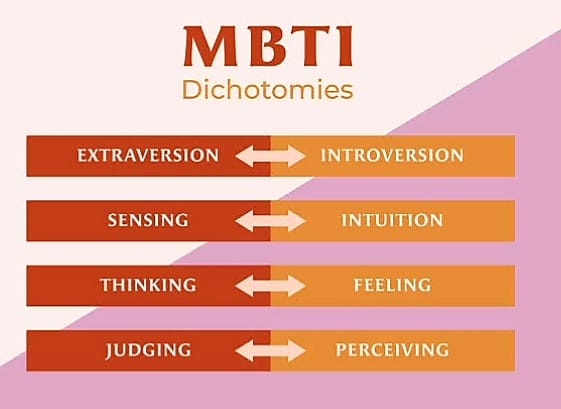
These cognitive functions are eight in number, with their energies directed either inwards(i) or outwards(e).
•Thinking: Ti and Te
•Intuition: Ni and Ne
•Sensing: Si and Se
•Feeling:Fi and Fe
Now, what do these cognitive functions mean?
Introverted (I) in cognitive function means the focus of the user is inner structure.
Extroverted (E) in cognitive function means the focus is the outer structure.
That’s why all (I) functions work from outside in,
•Ti: Introverted thinking, works on the basis of internalizing and structuring of logic, concepts and ideas.
•Fi: Introverted feeling, works on the basis of personal values, feelings and preferences.
•Si: Introverted sensing, works on the basis of inner understanding of structured patterns, memories and connections.
•Ni: Introverted intuition, works on the basis of inner sense of direction, intangible patterns and hunches.
While extroverted (E) functions work from inside out.
•Te: Extroverted thinking, works by organizing and structuring the outside world, by arranging the data into lists and forms.
•Fe: Extroverted feeling, works on the basis of group and shared values. Basically the group feelings.
•Se: Extroverted sensing is all about noticing the patterns in the present, and being active in the present moment.
•Ne: Extroverted intuition is all about grasping as much ideas and information as one can.
Note how feeling and thinking functions are associated with “doing” and sensing and intuition functions are associated with “understanding”. So that’s why T and F functions are called Judging functions, because they’re decision making functions. While S and N functions are called Perceiving functions, because they are information collecting functions.
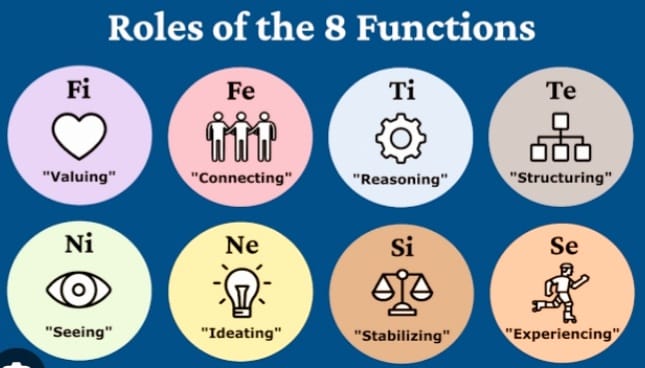
How to recognize these functions in a person?
There are some “Traits” associated with each function, especially when they are used in a dominant position (present high on the stack of functions). So, it really takes observation.
• Ne: Ne users tend to have a very curious mind, they are interested in collecting more and more information about a topic, and have a very varied interest. They also tend to change topics a lot during a conversation and can randomly think of something to say.
• Se: Se users are the hyperactive types, you’ll mostly find them restless, very much aware of their surroundings and very keen on how they use their senses. They’re observant of the present and living in the moment.
• Fe: Fe users are aware of the social norms, group values and shared emotional goals.
You’ll find them mostly finding a common ground in case of a conflict, and constantly supporting the underdog. A person who knows how to talk to people according to their needs is a Fe user.
•Te: Te users are seen leading and taking charge of a situation. You’ll mostly find them, making rules to arrange a group, taking charge to get things done, and putting order in a place or a group.
The observation of these extroverted traits in a person is very easy. The introverted function requires a more personal and individual approach to be observed.
•Ni: Can be observed in a person who follows their hunch. Usually not as curious as a Ne user, but mostly on point about whatever they want. Their intuition can be seen ahead in the future and you’ll see them planning their goals more often.
•Si: Can be observed in person with a brilliant memory. You’ll usually see them saying “it had happened like that before” or “that’s how we do this thing” etc. They’re systematic, and précis in their observation, and mostly refer to deeds of past due to the connection they see in the present.
•Fi: Can be observed in super private individuals. They don’t like to share their personal details with you, are fixed on their beliefs and have a moral system. You might find them very rigid about their beliefs and you might not find them changing it too often. Also these individuals are fairly sensitive and can be easily hurt. They also rely on their heart for decision making.
•Ti: Can be observed in a person who likes to play with logic. You’ll find them seeking solutions to the problems, discussing right and wrong and relying on mind in the decision making process rather than on heart.
How to type a person based on these observations?
Each type has a dominant function, a secondary function, a tertiary function and an inferior function. While they naturally rely on the first two, you can still see the usage of the last two in action at times.
A person will be using their dominant and secondary functions more mindfully than the last two, and it’ll come naturally to them.
• So, the first step is to recognize their dominant function.
Now, each function has an opposite that co-exists with them.
For thinking, it’s feeling and for sensing, it’s intuition.
Now, if any of them is an introverted function recognized in a person (in the dominant position), the other will be an extroverted, or vice versa.
It means that,
•Ti will exist with Fe.
•Te will exist with Fi.
•Si will exist with Ne.
•Se will exist with Ni.
It’s a way to balance the opposite energies of two very different types of functions.
Point to note, a person with an introverted dominant function is most likely to be an introvert and an extroverted dominant function is more likely to be an extrovert.
• So, the second step is to find the opposite co-existing function of their remaining stake.
Now, you have two functions from their stack, and the other two functions you don’t know. You’re now going to check their type by putting them on to the traits of each type as a whole and noting the characteristics they most identify with. This checking will identify the remaining functions from their stack.
•So, the third step is to check the type they most identify with, based on their dominant function.
For example:
An introverted individual, observed to have an excellent sense of intangible direction and pattern recognition with future orientation (Dominant Ni), has an opposite function (Se) in their stack and they can either be infj or an intj.
According to the traits of mbti types, infjs are people oriented, while intjs are seen as goal oriented.
Because Infj has a secondary Fe function (that co-exists with Ti)
And Intj has a secondary Te function (that co-exists with Fi).
When either of these traits is observed in the person, their remaining functions will be known and their type will be identified.
Shadow functions in MBTI
This is a theory in Mbti that suggests that each type has a full stack of all eight functions, in different orders. That explains why a type unconsciously behaves as a different type when faced with a challenge.
Shadow function stack is the same function with opposite energies in the same order.
For example:
Infj functions are Ni-Fe-Ti-Se
Its shadow is enfp, whose cognitive functions are Ne-Fi-Te-Si.
These shadow functions are required to be mastered in order to work mindfully on the unconscious obstacles.
A brief overview: Basic traits of all 16 MBTI types
When we talk about the 16 personality types, we can observe the following traits easily in all of them.
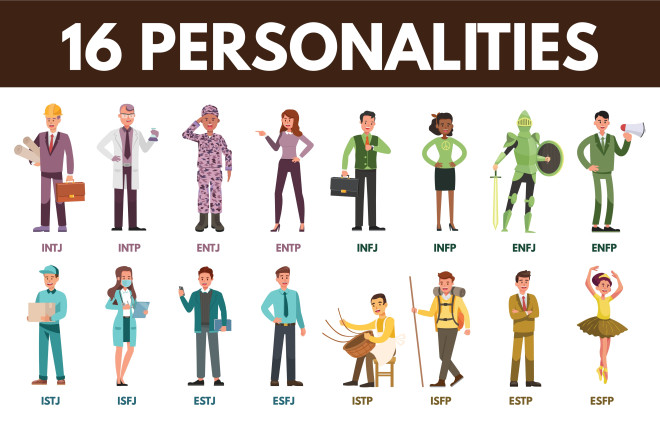
ISTP:
ISTP are also considered as a craftsperson as they are independent, action oriented, logical and usually prefer to work at their own place.
ISTJ:
ISTJ are generally considered as reserved and quiet people but they are trustworthy and sincere to their loved ones. They prefer to take orders in an organization and work practically.
ISFP:
ISFP usually have an artistic mind. They are sensitive and easy-going people and at the same time they have aesthetically motivated personalities. They focus on dreams and how to achieve them practically.
ISFJ:
ISFJ is the group of people having compassionate, responsible and pragmatic behavior. They are just like a protector in any family.
INFJ:
INFJ are considered as best counselors. They always try to help others according to their level of potential. Apart from that they are dependable, intellectual and insightful people.
ESFJ:
ESFJ are friendly, outgoing and productive people. They somehow become a reliable source of information for others in their surroundings.
ENFP:
ENFP are enthusiastic, creative, charming and love to talk. They have strong networking skills. They always have a strong bond with their surrounding people. They have the ability to begin a new project and engage people to make it successful.
ESTJ:
ESTJ are usually hard working and efficient people but they are known as traditionalists. They always follow the trend and become successful by becoming experts in their field.
ESTP:
ESTP are highly energetic people. They are curious, versatile and spontaneous. They love to go for adventures in life. They feel pleasure in thrill seeking.
INFP:
INFP is a sensitive, creative and idealist who has strong beliefs and values. They always focus on their dreams and the possibilities to achieve their goals.
INTJ:
INTJ are considered masterminds in any team. They are problem-solvers as they have analytical nature. They always prefer to go towards innovation and some kind of improvement
INTP:
People with an INTP personality are reserved, flexible and original thinkers. They are fascinated by designs and systems.
ESFP:
ESFP are also known as Champion all over because of their energetic, warm, enthusiastic, spontaneous, supportive, and passionate personality. They love developing new ideas in their mind and they know how to convert their ideas into a reality.
ENTJ:
ENTJ are known as captain of the ship or strategic leader as they have a vision. They are long term planners, independent and they have talent to organize people. They know how to find new solutions to the issues and how-to bring change in an organized way.
ENFJ:
ENFJ have a teacher type personality in many ways. They are organized, responsible and skilled communicators. They are considered as catalysts for human growth due to their ability to persuade people towards the targeted goal according to their potential level.
ENTP:
ENTP are famous as a visionary mind. They are inventive, strategic and enthusiastic. They get inspired by complex and challenging problems. They love solving puzzled situations. They find pleasure in searching new ways all the time.
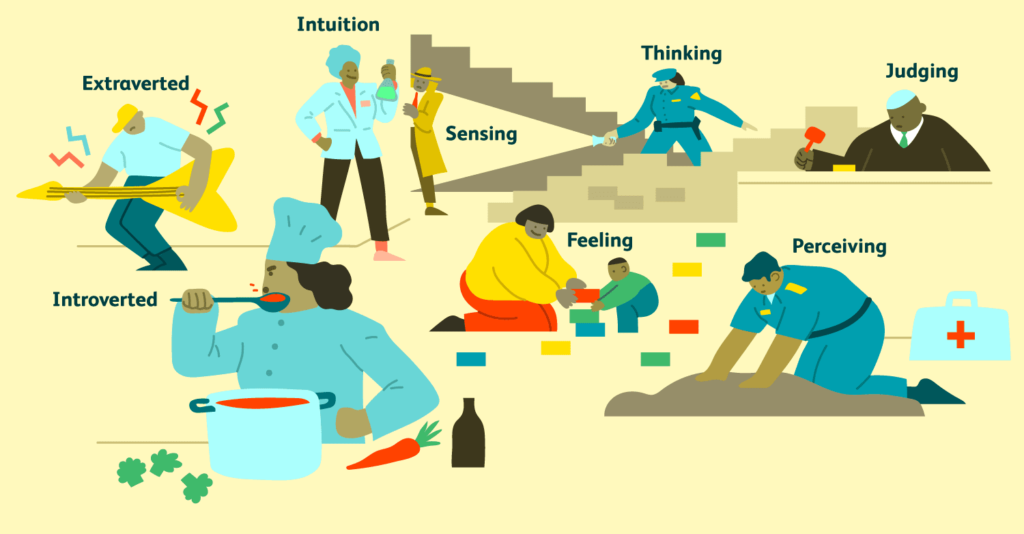
From the traits mentioned above, we realize that every sensing type is more or less a traditionalist. They’re excellent in picking up the trends and they easily go with the latest trend that is going on around them. They’re also more likely to work by hand, gain physical experience and less open-minded to possibilities/ideas. Since they have Se surpassing their Ni, they usually are more present oriented however learn to take things for longer terms. High Si compared to Ne is more traditional than se users, but later learn to discover the possibilities and tend to become creative.
On the other hand, every intuitive type is rebellious. They always think out of the box and question a lot about whatever is going around them. Ne surpassing Si is difficult to satisfy, so expect a whole mind blowing conversation with them. Ni surpassing Se are usually more sober, and focused on one direction. Usually, introverted intuitive are alone wolves who prefer solitude however extroverted intuitive get along well with people and feel comfortable around them due to their high Fe/Fi.
Some randomly observed facts
• A thinker adjusting in feelers is a huge disappointment. Both are built differently and are adjusting without mutual compassion, which is very unsatisfying.
• Fi users are more focused on morals, Fe users are fixed on connections. Fi users are more likely to be seen as a good humble partner in the long term as compared to the Fe. While Fe users are tactful in short term peace keeping.
• Te leading types are as restless as Se leading ones, except they think in the long term. Their range starts from present to far future, while Se users are present oriented.
• Most difficult to understand cognitive functions are Fi and Fi. Both in action appear very similar and most people confuse them. So there is a trick. Fi is based on personal observation and emotional attachment. There may or may not be a connection to the outer world or logic. Ni is a realization of facts and connections to predict the future. It’s more complex than Fi and comparatively easier to explain.
• Sensors with se in lead tend to be very goal oriented. Thanks to the tertiary Ni in their stack.
• INFJ stack is said to be an ideal function stack. Due to the combination of Ni – Se axis with Ti – Fe that makes them both thinker and feeler, intuitive and sensor.
• All Fe leading types can be very manipulative.
• Ti with Ne combination is a very complex person. Often gets misunderstood. However Fe and Si positions are ideal to spot out any inconsistencies in people and situations. Thus, providing them with the privilege of unbiased analysis,
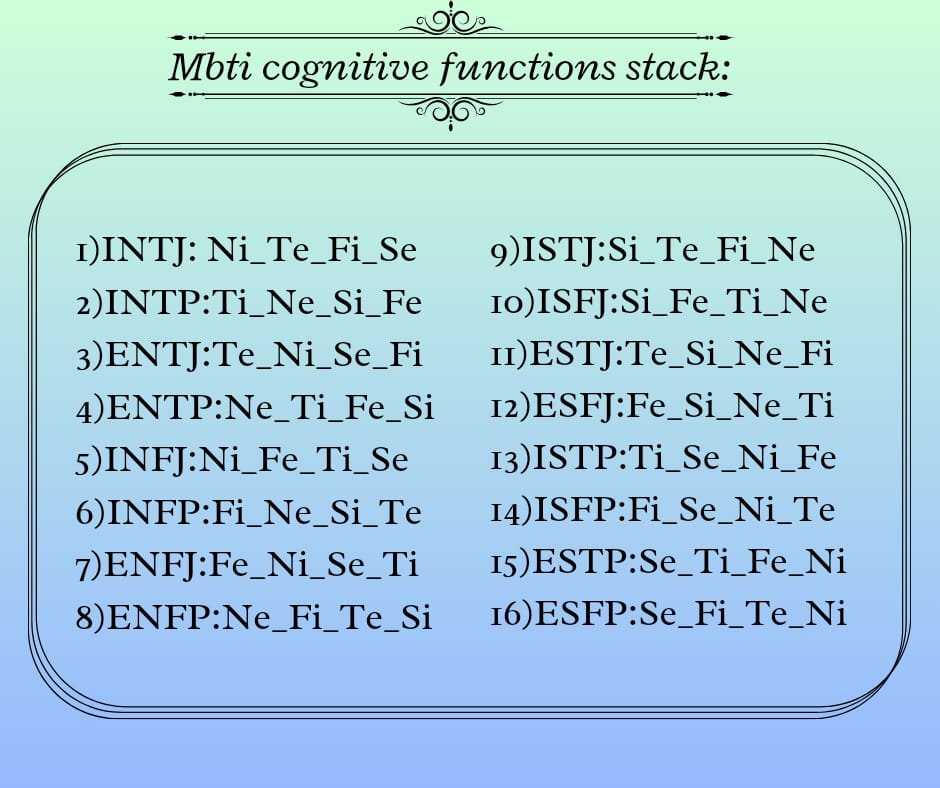
• A shadow of any type, if not understood correctly, can manifest negatively. That’s why it’s better to understand the usage of shadow functions to utilize them in the best possible way.
Below are some sites you can test your type in.
Personality Test Based on Jung and Briggs-Myers – Idrlabs
https://www.idrlabs.com/test.php
Socionics Type and Cognitive Function Test
Mistype.Investigator
https://mistypeinvestigator.com/
Free Personality Test
https://www.16personalities.com/free-personality-test
To further study this topic, we would recommend you to read the articles present on these sites.
A JOINT ARTICLE
BY
FARZEEN FATIMA & NABEEL RASHID
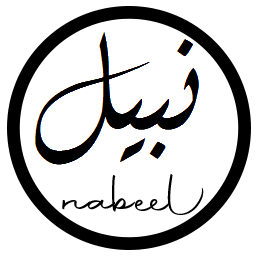
Nice and easier way to convey the mind preferences. How well psychology topic discussed Bravo….
Credit goes to both the authors Nabeel and Fatima..
I am glad that you liked it.
Amazing Article 💪
Thanks
Beautifully explained the depth of human mind..
I’m an introvert, intuitive, feeler and judger. INFJ
A fairly easier way to understand the different types of personalities. Good job
Thanks a lot Mam. Your comment is always a source of courage and motivation for us.
A fairly easier way to understand the different types of personalities. Good job